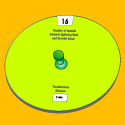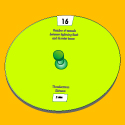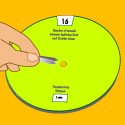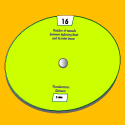



Experiment Category:
Objective:
What You Need:
- Scissors
- Brass fasteners
- Thumb tack or pushpin
- Thunder-Lightning Calculator Handouts
To Do and Observe:
1. Cut out the cover sheet circle.
2. Bend the cutout, loosely, so that you can cut out the square window (marked with a X) located at the bottom of the circle.
3. Cut out the second data circle.
4. Use a thumbtack or pushpin to make a hole at the center of both circles.
5. Push the brass fastener through the center of both circles to hold them together.
6. Wait for a thunderstorm! When you see the lightning, count how many seconds pass until you hear the thunder.
7. Turn the outer circle until it reveals the number of seconds between lightning flash and thunder boom. Look through the window to see the thunderstorm distance.
What's Going On:
Lightning is one of the most powerful forces of nature. Today, scientists are learning more and more about what happens when a flash of lightning streaks across the sky. Lighting is a very large electrical spark. The spark is caused by the tiny particles called electrons. Electrons are much too small to see. However, during a lightning flash, electrons shoot through the air so fast they make the air around them glow. A streak of lightning shows the path the electrons follow as they blast their way forward. Except for its size and power, lightning is no different from the spark you can create by shuffling your feet on the carpet and touching metal. Both are electrical charges caused by friction (the rubbing of one object against another).
Lightning can travel at speeds up to 93,000 miles per second and may heat the air it passes to temperatures between 15, 000 and 60,000 degrees Fahrenheit in a millionth of a second. The extreme heat causes the air to expand suddenly and violently, producing the sound called thunder. Since light travels at a faster rate than you always see lightning before you hear the boom of thunder. The longer the distance both the light and the sound travel, the further the sound waves will lag behind the light waves. Imagine you were racing against an Olympic track athlete. If you raced over a short distance, the olympian would win. The longer the race, the longer the olympian’s margin of victory!
Lightning can be seen almost instantly, but the sound of thunder takes five seconds to travel one mile. Light travels at 300,000 km/sec and reaches the earth from the sun in only eight seconds. Sound travels at .333 km/sec seconds or a mile in five seconds.
When you see the flash, count the seconds until you hear the thunder. Divide the number of seconds by five to determine the distance in miles. For every five seconds that you count, the lightening flash is one mile away. Time is the “ratio” of distance divided by velocity. The mathematical formula is:
Distance = Velocity x Time
If you count twenty seconds, the lightning is approximately four miles away. If you see a flash of lightning but don’t hear thunder, the lightning was probably too far away to hear. Thunder from lightning discharged more than fifteen or more miles away is not usually heard.
Parent/Teacher Tips:
For Older Students
Give the older students the cover sheet only and have them generate the second sheet through calculations. The sound of the thunder can travel one mile for every five seconds that you count. Using this piece of information, have the students figure out the distance of the lightning for 1-25 seconds. You can scale down the number of calculations that they do, for instance, by having the groups of students calculate the distance for a certain number of seconds, and sharing their results.

Comments
Experiment on your website